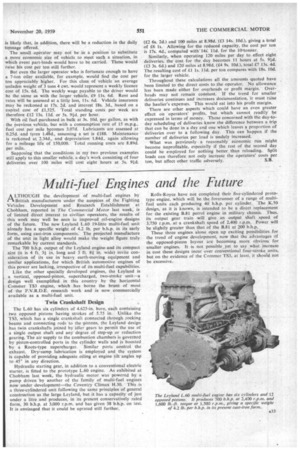Multi-fuel Engines and the Future
Page 67

If you've noticed an error in this article please click here to report it so we can fix it.
ALTHOALTHOUGH the development of multi-fuel engines by UGH manufacturers under the auspices of the Fighting Vehicles Development and Research Establishment at Chobliam, reported in The Commercial Minor last week, is of limited direct interest to civilian operators, the results of this work may well be seen in improved oil-engine designs of the future. The new Leyland L.60 19-litre multi-fuel unit already has a specific weight of 4.2 lb. per b.h.p. in its early form, using cast-iron components. The projected manufacture of the unit in light alloy would make the weight figure truly remarkable by current standards.
The 700 b.h.p. output of the Leyland engine, and its compact size (it is 4 ft. 3i in. long and 3 ft. 84 in. wide) invite consideration of its use in heavy earth-moving equipment and similar applications, for which British automotive engines of this power are lacking, irrespective of its multi-fuel capabilities.
Like the other specially developed engines, the Leyland is a vertical, opposed-piston, supercharged, two-stroke unit-a design well exemplified in this country by the horizontal Commer TS3 engine, which has borne the brunt of most of the F.V.R.D.E. research work and is now commercially available as a multi-fuel unit.
Twin Crankshaft Design
The L.60 has six cylinders of 4.625-in, bore, each containing two opposed pistons having strokes of 5.75 in. Unlike the TS3, which has a single crankshaft connected through rocking beams and connecting rods to the -pistons, the Leyland design has twin crankshafts joined by idler gears to permit the use of a single output shaft and any degree of step-up or reduction gearing. The air supply to the combustion chambers is governed by piston-controlled ports in the cylinder walls and js boosted by a Roots-type supercharger. Similar ports control the exhaust. Dry-sump lubrication is employed and the system is capable of providing adequate oiling at engine tilt angles up to 45° in any direction.
Hydraulic starting gear, in addition to a conventional electric starter, is fitted to the prototype L.60 engine. As exhibited at Chobham last week, the hydraulic motor was powered by a pump driven by another of the family of multi-fuel engines now under .development-the Coventry Climax H.30. This is a three-cylindered unit following the same principles of general construction as the large Leyland, but it has a capacity of just under a litre and produces, in its present conservatively rated form, 30 b.h.p. at 3,000 r.p.m. and has given 38 b.h.p. on test. It is envisaged that it could be uprated still further.
Rolls-Royce have not completed their five-cylindered prototype engine, which will be. the forerunner of a range of .multifuel units each producing 40. b.h.p. per cylinder.. 'The K.50 design, as it is known, is intended to be a direct replacement for the existing B.81 petrol engine in military chassis. Thus, its output gear train will give an output shaft speed of 3;750 r.p.m. at a crankshaft speed of 2,400 r.p.m. Power will be slightly greater than that of the B.8I at 206
These three engines alone open up exciting possibilities for the trend of engine development, now that the advantages of the opposed-piston layout are becoming more obvious for smaller engines. It is not possible yetto say what increase in cost these designs incur over conventional four-stroke units, but on the evidence of the Commer TS3, at least, it should not be excessive..




































































































